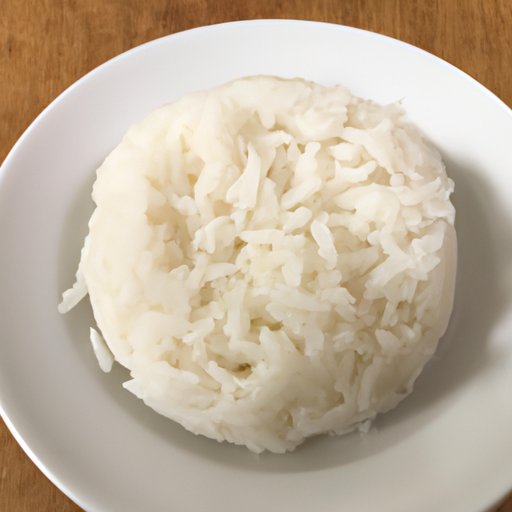Introduction
Rice is one of the most widely consumed grains in the world, and it plays an important role in many cultures and cuisines. One of the most popular ways to prepare rice is by steaming, which is a relatively simple and fast cooking method. But is steamed rice healthy? This article will explore the nutritional value and health benefits of eating steamed rice.

Exploring the Nutritional Benefits of Steamed Rice
Steamed rice is a good source of carbohydrates, protein, and fiber. One cup (158 grams) of cooked white rice provides 205 calories, 4.5 grams of protein, 0.6 grams of fat, 45 grams of carbohydrates, and 1.6 grams of fiber.
In addition to macronutrients, steamed rice also contains a variety of vitamins and minerals. White rice is a good source of thiamin, niacin, and folate. Brown rice is particularly high in these nutrients, as well as magnesium, phosphorus, and zinc.
There are also some potential health benefits associated with eating steamed rice. Studies have shown that eating whole grains, such as brown rice, may reduce the risk of certain chronic diseases, including heart disease, diabetes, and colon cancer. Additionally, regular consumption of brown rice has been linked to lower levels of “bad” LDL cholesterol and higher levels of “good” HDL cholesterol.

Comparing Steamed Rice to Other Types of Cooked Rice
When it comes to the health benefits of steamed rice, it is important to consider the type of rice being consumed. White rice is more highly processed than brown rice, and therefore, has fewer nutrients and a higher glycemic index. Brown rice is a better source of vitamins and minerals, and it has a lower glycemic index, which means it is less likely to cause spikes in blood sugar levels.
It is also important to consider the difference between boiled and steamed rice. Boiling rice involves submerging the grains in boiling water for a period of time, whereas steaming rice involves placing the grains on top of boiling water and allowing the steam to cook them. The boiling method results in a softer texture, while the steaming method results in a firmer texture.

Examining the Health Risks of Consuming Too Much Steamed Rice
Although steamed rice can be a part of a healthy diet, there are some potential health risks associated with consuming too much of it. For example, eating too much steamed rice can lead to an overconsumption of calories, which can lead to weight gain. Additionally, consuming large amounts of white rice may increase the risk of arsenic poisoning, as it is often grown in areas with high concentrations of arsenic in the soil.
Investigating the Effect of Cooking Methods on the Nutritional Value of Rice
The cooking method used to prepare rice can also affect its nutritional value. For example, boiling rice can cause some of the vitamins and minerals to leach into the cooking water, resulting in a lower nutrient content. Pressure cooking, on the other hand, has been shown to retain more of the vitamins and minerals, as well as the fiber, compared to other cooking methods.
Evaluating the Role of Steamed Rice in a Healthy Diet
When it comes to incorporating steamed rice into a healthy diet, portion size is key. The American Heart Association recommends limiting your intake of refined grains, such as white rice, to no more than half of your daily grain intake. Additionally, the Dietary Guidelines for Americans recommends consuming at least three servings of whole grains each day, such as brown rice.
If you are looking for alternatives to steamed rice, there are plenty of other grains to choose from. Quinoa, millet, barley, and oats are all excellent sources of vitamins, minerals, and fiber. They can be cooked in a similar way to rice and can be used as a side dish or added to salads and soups.
Conclusion
Steamed rice can be a nutritious and tasty addition to your diet. It is a good source of carbohydrates, protein, and fiber, and it contains a variety of vitamins and minerals. Eating steamed rice may also provide some health benefits, such as reducing the risk of certain chronic diseases. However, it is important to be aware of the potential health risks associated with overconsuming steamed rice, such as an overconsumption of calories and the risk of arsenic poisoning.
When it comes to incorporating steamed rice into a healthy diet, it is important to consider the type of rice being consumed and the cooking method used. In general, brown rice is a better source of nutrients than white rice, and pressure cooking has been shown to retain more of the vitamins and minerals. Additionally, it is recommended to limit your intake of refined grains, such as white rice, and consume at least three servings of whole grains per day. For those looking for alternatives to steamed rice, there are plenty of other grains to choose from.
(Note: Is this article not meeting your expectations? Do you have knowledge or insights to share? Unlock new opportunities and expand your reach by joining our authors team. Click Registration to join us and share your expertise with our readers.)
